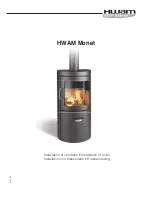
7
Fig.
№
. 6
Two way safety valve DBV 1 - 02
In the system, it is necessary to install a safety valve with max. overpressure of 400 kPa (4 bar), which dimensions must correspond
to the boiler nominal output. The safety valve must be installed immediately behind the boiler. Shut-off valve must be installed
between the safety valve and the boiler. For further questions please contact our contractual installation companies and service
organizations.
Specifications of the two-way safety valve DBV 1 - 02 (from Regulus)
Opening temperature (limit):
100 °C (+0° - 5 °C)
Maximum temperature:
120 °C
Maximum pressure on the boiler side:
400 kPa (4 bar)
The maximum pressure on the water side:
600 kPa (6 bar)
Nominal flow at
p 100 kPa (1 bar):
1.9 m
3
/h
Use
Two-way safety valve DBV 1 - 02 is designed for central heating boilers protection against overheating. In the valve drum, the discharge and
refill valves are controlled by thermostatic element. When achieving the limit temperature the discharge and refill valve open simultaneously,
which means that cold water flows into the boiler while hot water is drained from the boiler. When the temperature drops below the limit, the
discharge and filling valves are closed simultaneously.
ATTENTION! Do not replace the safety valve.
In case of reaction of the two-way safety valve, when there could be refilled water that does not conform to CSN 07 7401, it is
necessary to adjust water in the system so that it again conforms to this standard.
Fig.
№
. 7
Recommended diagram of the two-way safety valve DBV 1 - 02 connection
Installation
Installation may only be performed by a qualified person. For proper operation of the thermostatic two-way safety valve it is necessary to comply
with the prescribed conditions for its installation and respect the flow directions indicated on its body. The safety valve is always mounted in the
output pipe of the boiler or directly on the boiler in its upper part where the heated water leaves boiler and is transported into the heating system.
When installing the valve, it is necessary to check whether the use of the 3/4“ socket, which can be both in the pipeline and on the boiler,
ensures complete immersion of the valve thermostatic element after the valve installation. After mounting into the socket, at the point "C" (Fig.
6), the discharge pipe is connected through which the hot water from the boiler will flow to drain. At the point "A" (Fig. 6), the supply of cooling
water is connected (Fig. 7), which ensures cooling the boiler down after the valve putting into operation. At the cooling water inlet, a filter to
remove mechanical impurities must be installed. At the point "B" (Fig. 6) there is connected the pipeline, which according to Fig. 7 leads to the
return line of the heating system near the boiler.
Regular maintenance
1x per year, turn the safety valve head to remove possible contaminants seated in it. Clean the filter at the cooling water inlet.
In case of using an open expansion tank, the safety device against overheating is not necessary.
Every heat source in an open heating system must be connected with the open expansion tank positioned located at the highest point of the
heating system. The expansion tanks must be designed to accommodate changes in water volume resulting from heating and cooling.
The open expansion tanks must be equipped with non-closable vent and overflow pipes. The overflow pipe must be designed to safely drain the
maximum flow volume entering the system. This can be achieved by rating the overflow pipes by one DN higher than the filling pipe. The
expansion tanks and their connecting pipes must be designed and positioned so as to reliably prevent them from freezing.
A - cold water inlet
B - output to the boiler
C - output to the drain
D - input from the boiler
1.
Boiler
2.
Two-way safety valve DBV 1 - 02
3.
Safety valve
4.
Reducing valve
5.
Filter
6.
Ball valve
7.
Pump
8.
Excess heat removal
9.
Discharge valve
I – Cold water inlet
II – Heating water outlet
III – Return water inlet







































